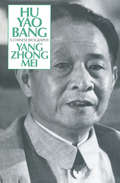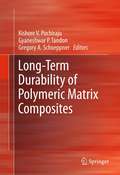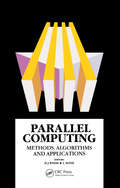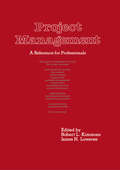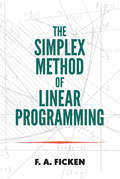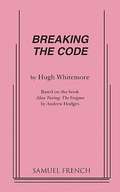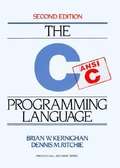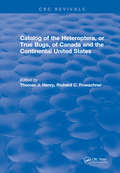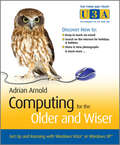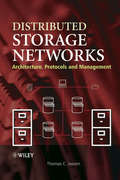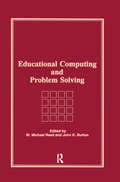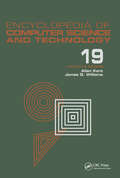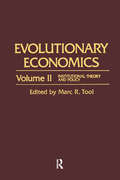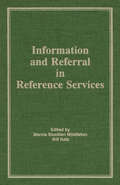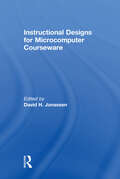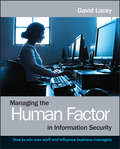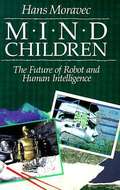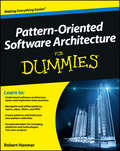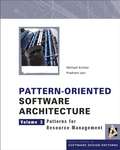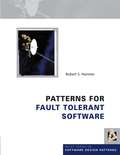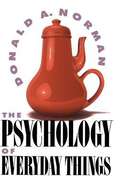- Table View
- List View
Hu Yao-Bang: A Chinese Biography
by Zhongmei YangCompares IT parks within the Asian Pacific in search of strategies that policy makers can adopt to: reduce the global digital divide; advance distributional equity; and soften some of the negative effects of economic globalization. "Best practices" are suggested based on these cases.
Long-Term Durability of Polymeric Matrix Composites
by Gyaneshwar P. Tandon Gregory A. Schoeppner Kishore V. PochirajuLong-Term Durability of Polymeric Matrix Composites presents a comprehensive knowledge-set of matrix, fiber and interphase behavior under long-term aging conditions, theoretical modeling and experimental methods. This book covers long-term constituent behavior, predictive methodologies, experimental validation and design practice. Readers will also find a discussion of various applications, including aging air craft structures, aging civil infrastructure, in addition to engines and high temperature applications.
Parallel Computing: Methods, Algorithms and Applications
by David J Evans; C SuttiParallel Computing: Methods, Algorithms and Applications presents a collection of original papers presented at the international meeting on parallel processing, methods, algorithms, and applications at Verona, Italy in September 1989.
Practical Astronomy with your Calculator or Spreadsheet
by Peter Duffett-Smith Jonathan ZwartNow in its fourth edition, this highly regarded book is ideal for those who wish to solve a variety of practical and recreational problems in astronomy using a scientific calculator or spreadsheet. Updated and extended, this new edition shows you how to use spreadsheets to predict, with greater accuracy, solar and lunar eclipses, the positions of the planets, and the times of sunrise and sunset. Suitable for worldwide use, this handbook covers orbits, transformations and general celestial phenomena, and is essential for anyone wanting to make astronomical calculations for themselves. With clear, easy-to-follow instructions for use with a pocket calculator, shown alongside worked examples, it can be enjoyed by anyone interested in astronomy, and will be a useful tool for software writers and students studying introductory astronomy. High-precision spreadsheet methods for greater accuracy are available at www. cambridge. org/practicalastronomy.
Project Management: A Reference for Professionals
by Kimmons""Highlighting the practical side of real-life project execution, this massive reference stresses project management as an independent profession--detailing the varied applications where project management is used and examining the numerous and diverse project management responsibilities and tools.
The Simplex Method of Linear Programming (Dover Books on Mathematics)
by F. A. FickenThis concise but detailed and thorough treatment discusses the rudiments of the well-known simplex method for solving optimization problems in linear programming. Geared toward undergraduate students, the approach offers sufficient material for readers without a strong background in linear algebra. Many different kinds of problems further enrich the presentation. The text begins with examinations of the allocation problem, matrix notation for dual problems, feasibility, and theorems on duality and existence. Subsequent chapters address convex sets and boundedness, the prepared problem and boundedness and consistency, optimal points and motivation of the simplex method, and the simplex method and tableaux. The treatment concludes with explorations of the effectiveness of the simplex method and the solution of the dual problem. Two helpful Appendixes offer supplementary material.
Teenagers From Outer Space
by Mike PondsmithSo How Does a Six-Armed Green-Skinned Guy from Arcturus Get a Date on a Saturday Night? Yo, dude! Aliens from Beyond the Stars have invaded our planet! They're enrolling their kids in our schools, shopping in our shopping malls, and hanging out in our fast food joints! High school is never going to be the same again. Six-armed green-skinned guys from Arcturus are gonna date your kid sister! Silicon-based lifeforms are gonna poke their school lunch and wonder what it's supposed to be! On second thought, maybe high school won't be so different after all. What Is This Thing? Teenagers from Outer Space is a roleplaying game set on an Earth where fun-loving space aliens go to our high schools and party with the Earth kids. In the game you play the part of a teenager-alien or human-and have adventures fighting mutant monstrosities, saving the world from ravening rabbits from the X dimension, and getting your homework in on time. You're not a gamer? No sweat, dude. Teenagers is a giggle. You'll have fun reading it, even if you never play. (Honest. Hey, trust us on this one, okay?) And if you decide to play, it'll be a snap. Unlike other roleplaying games, Teenagers doesn't have encyclopedia-long rules that you have to study like a textbook before you can play. You can learn to play this thing in minutes. Seconds, even. . . . Well, okay, maybe not seconds. And if you are a gamer-hey, butchering orcs is swell for a while, but isn't it time for a change of pace? Dragons are dangerous and dungeons are deadly, but there's nothing quite as awesome, quite as fearful, quite as horrifying as an order to report to...the principal's office!
Breaking the Code
by Hugh WhitemoreDerek Jacobi took London and Broadway by storm in this exceptional biographical drama about a man who broke too many codes: the eccentric genius Alan Turing who played a major role in winning the World War II; he broke the complex German code called Enigma, enabling allied forces to foresee German maneuvers. Since his work was classified top secret for years after the war, no one knew how much was owed to him when he was put on trial for breaking another code the tab.
The C Programming Language (Second Edition)
by Brian Kernighan Dennis RitchieIntroduces the features of the C programming language, discusses data types, variables, operators, control flow, functions, pointers, arrays, and structures, and looks at the UNIX system interface.
Catalog of the Heteroptera or True Bugs, of Canada and the Continental United States
by Thomas J. HenryA primary aim of this catalog is to offer an accounting for each species as originally proposed and for the first usage only of all its name combinations (including valid names, synonymies, and misspellings) that have been published for our area. We follow the policy outlined by the 1985 Code of Zoological Nomenclature for nonmenclatorial proposes that a dissertation for an advanced educational degree is not published unless it satisfies the criteria present in Articles 8 and 9.
Computing for the Older and Wiser
by Adrian ArnoldComputing for the Older & Wiser is a simple-to-follow user friendly guide aimed at the older generation introducing the basics of mastering a computer. Covering the latest release of Windows Vista Home Premium(TM) and Windows XP(TM), this book is designed for people who want straightforward instructions on how to use their home PC.Written in plain English, using no unintelligible 'computer speak' Adrian guides you step-by-step through the basics of computing including chapters on:Use of the keyboard and mouseEmail and the InternetCustomising your desktopWord processingDigital photographyUseful websitesand much moreUseful tips and tricks and a question and answer revision section in each chapter will build your confidence, get you up-to-date and technologically savvy in no time!If you want to learn how to search and shop online, email or chat to family and friends, and you have the enthusiasm to learn a new skill then this book is for you.With explanatory screenshots in full colourEasy to read fontSupplementary website - including additional exercises to help improve your PC skills, further online hints and tips, and a directory of useful resources. www.pcwisdom.co.uk"Computing for the Older & Wiser will take readers comfortably through getting started on their home PC. The content is similar to what we would take our clients through if they were to attend a class, which is exactly the right level."--Faye Lester, Computer Training Coordinator, Age Concern Camden, UK"I have not had so much fun for years"--Renee Moore, 79, pupil at Age Concern, Colchester, UK
Distributed Storage Networks
by Thomas C. JepsenThe worldwide market for SAN and NAS storage is anticipated to grow from US $2 billion in 1999 to over $25 billion by 2004. As business-to-business and business-to-consumer e-commerce matures, even greater demands for management of stored data will arise.With the rapid increase in data storage requirements in the last decade, efficient management of stored data becomes a necessity for the enterprise. A recent UC-Berkeley study predicts that 150,000 terabytes of disk storage will be shipped in 2003. Most financial, insurance, healthcare, and telecommunications institutions are in the process of implementing storage networks that are distributed to some degree. For these institutions, data integrity is critical, and they will spend much time and money on planning.One of the primary obstacles to implementing a storage network cited by enterprise IT managers is a lack of knowledge about storage networking technology and the specific issues involved in extending a Storage Area Network (SAN) or Network Attached Storage (NAS) over the Metropolitan Area Networks (MAN) or Wireless Area Networks (WAN). Distributed Storage Networks : Architecture, Protocols and Management addresses the "terminology gap" between enterprise network planners and telecommunications engineers, who must understand the transport requirements of storage networks in order to implement distributed storage networks. Jepsen comprehensively provides IT managers, planners, and telecommunications professionals with the information they need in order to choose the technologies best suited for their particular environment.* Addresses a hot topic that will become increasingly important in the coming years* Enables high-level managers and planners to make intelligent decisions about network needs.* Includes example network configurations providing solutions to typical user scenarios* Fills the "terminology gap" between enterprise network managers and telecommunications engineers who must understand the transport requirements of storage networks in order to implement distributed storage area networksA fundamental resource for all network managers, planners and network design engineers, as well as telecommunications engineers and engineering, computer science, and information technology students.
Educational Computing and Problem Solving
by W Michael Reed John K BurtonFirst published in 1988. Professionals who are on the cutting edge of educational computing discuss, in this provocative new book, one of the most exciting prospects of the field--harnessing the power of the computer to enhance the development of problem-solving abilities. Here is everything that educators will need to know to use computers to improve higher level skills such as problem solving and critical thinking. Current aspects of problem-solving theory, a philosophical case for including programming languages in the curriculum, state-of-the-art research on computers and problem solving, and a look at problem-solving software are included in this comprehensive volume. The research and its application to instruction are grounded in problem-solving theory--making this book a unique and critical addition to the existing literature.
The Emperor's New Mind
by Roger PenroseWinner of the 1990 Science Book Prize arguing AGAINST artificial intelligence, and exploring the mystery of the mind and consciousness, Roger Penrose takes the reader on the most engaging and creative tour of modern physics, cosmology, mathematics and philosophy that has ever been written.
Encyclopedia of Computer Science and Technology: Volume 19 - Supplement 4: Access Technoogy: Inc. to Symbol Manipulation Patkages (Computer Science And Technology Encyclopedia Ser.)
by Allen Kent"This comprehensive reference work provides immediate, fingertip access to state-of-the-art technology in nearly 700 self-contained articles written by over 900 international authorities. Each article in the Encyclopedia features current developments and trends in computers, software, vendors, and applications...extensive bibliographies of leading figures in the field, such as Samuel Alexander, John von Neumann, and Norbert Wiener...and in-depth analysis of future directions."
Evolutionary Economics
by Marc R. ToolThis two-volume work is intended to map the theoretical heartland of the institutionalist perspective on political economy. Volume I, "Foundations of Institutional Thought", identifies the origins of institutional economics and explores the primary analytical tools in its development. The papers included in Volume II, "Institutional Theory and Policy", consider basic economic processes, institutions for stabilizing and planning economic activities, the role of power and accountability, and emerging global interdependence. Marc R. Tool is the editor of "Journal of Economic Issues".
Information and Referral in Reference Services
by Linda S KatzThis book investigates a wide variety of situations and models which fall under the umbrella of information and referral. It examines traditional views in public libraries and library systems as well as descriptions of programs in nontraditional settings, such as academic libraries. A human services perspective is explored and research models are presented.
Instruction Design for Microcomputing Software
by David H. JonassenSelected as one of the outstanding instructional development books in 1989 by the Association for Educational Communications and Technology, this volume presents research in instructional design theory as it applies to microcomputer courseware. It includes recommendations -- made by a distinguished group of instructional designers -- for creating courseware to suit the interactive nature of today's technology. Principles of instructional design are offered as a solid base from which to develop more effective programs for this new method of teaching -- and learning.
Managing the Human Factor in Information Security
by David LaceyWith the growth in social networking and the potential for larger and larger breaches of sensitive data,it is vital for all enterprises to ensure that computer users adhere to corporate policy and project staff design secure systems. Written by a security expert with more than 25 years' experience, this book examines how fundamental staff awareness is to establishing security and addresses such challenges as containing threats, managing politics, developing programs, and getting a business to buy into a security plan. Illustrated with real-world examples throughout, this is a must-have guide for security and IT professionals.
Mind Children: The Future of Robot and Human Intelligence
by Hans MoravecArguing that within the next fifty years machines will equal humans not only in reasoning power but also in their ability to perceive, interact with, and change their environment, the author describes the tremendous technological advances possible in thefield of robotics.
Pattern-Oriented Software Architecture For Dummies
by Robert HanmerImplement programming best practices from the ground upImagine how much easier it would be to solve a programming problem, if you had access to the best practices from all the top experts in the field, and you could follow the best design patterns that have evolved through the years. Well, now you can. This unique book offers development solutions ranging from high-level architectural patterns, to design patterns that apply to specific problems encountered after the overall structure has been designed, to idioms in specific programming languages--all in one, accessible, guide. Not only will you improve your understanding of software design, you'll also improve the programs you create and successfully take your development ideas to the next level.Pulls together the best design patterns and best practices for software design into one accessible guide to help you improve your programming projects Helps you avoid re-creating the wheel and also meet the ever-increasing pace of rev cycles, as well as the ever-increasing number of new platforms and technologies for mobile, web, and enterprise computing Fills a gap in the entry-level POSA market, as well as a need for guidance in implementing best practices from the ground upSave time and avoid headaches with your software development projects with Pattern-Oriented Software Architecture For Dummies.
Pattern-Oriented Software Architecture, Patterns for Resource Management
by Prashant Jain Michael KircherThe first volume of the POSA pattern series introduced a broad-spectrum of general-purpose patterns in software design and architecture. The second narrowed the focus to fundamental patterns for building sophisticated concurrent and networked software systems and applications. This volume uses design patterns to present techniques for implementing effective resource management in a system.The patterns are covered in detail making use of several examples providing directions to the readers on how to implement the presented patterns. Additionally, the volume presents a thorough introduction into resource management and a case study where the patterns are applied to the domain of mobile radio networks. The patterns are grouped by different areas of resource management and hence address the complete lifecycle of resources: resource acquisition, coordination and release.
Patterns for Fault Tolerant Software
by Robert HanmerSoftware patterns have revolutionized the way developer's and architects think about how software is designed, built and documented.This new title in Wiley's prestigious Series in Software Design Patterns presents proven techniques to achieve patterns for fault tolerant software. This is a key reference for experts seeking to select a technique appropriate for a given system.Readers are guided from concepts and terminology, through common principles and methods, to advanced techniques and practices in the development of software systems. References will provide access points to the key literature, including descriptions of exemplar applications of each technique.Organized into a collection of software techniques, specific techniques can be easily found with sufficient detail to allow appropriate choices for the system being designed.
The Psychology of Everyday Things
by Donald A. NormanEven the smartest among us can feel inept as we fail to figure our which light switch or oven burner to turn on, or whether to push, pull, or slide a door. The fault, argues this fascinating, ingenious—even liberating—book, lies not in ourselves, but in product design that ignores the needs of users and the principles of cognitive psychology. The problems range from ambiguous and hidden controls to arbitrary relationships between controls and functions, coupled with a lack of feedback or other assistance and unreasonable demands on memorization. The book presents examples aplenty—among them, the VCR, computer, and office telephone, all models of how not to design for people.But good, usable design is possible. The rules are simple: make things visible, exploit natural relationships that couple function and control, and make intelligent use of constraints. The goal: guide the user effortlessly to the right action on the right control at the right time. But the designer must care.
Steve Jobs: The Journey Is the Reward
by Jeffrey S. YoungSteve Jobs embarks on a new venture in Silicon Valley after resigning as Chairman with Apple Computers. He had to face hostilities from the management of the Apple Board in his new business. This book narrates his way to success.
